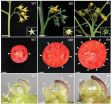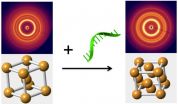(Press-News.org) Being very overweight in your teens may double the risk of developing bowel cancer by the time you are middle aged, suggests research published online in the journal Gut.
And a high level of an indicator of systemic inflammation--erythrocyte sedimentation rate, or ESR for short--at this age is also linked to heightened risk of the disease in later life, the study shows.
Adult obesity and inflammation have been associated with an increased risk of bowel cancer, which is the third most common form of cancer among men, worldwide. However, less is known about how obesity and systemic inflammation might be influential during late adolescence.
The researchers therefore tracked the health of almost 240,000 Swedish men, who had been conscripted into the military between the ages of 16 and 20 in 1969-76.
At enlistment, the men had a health check, which included weight and height, and ESR levels. The men were then monitored for bowel cancer up to 2010, using national cancer registry data.
At the time of conscription, nearly 12% of the men were underweight, while almost 81% were of normal weight. Some 5% were moderately overweight; 1.5% were very overweight; and 1% were obese.
During the monitoring period, which spanned an average of 35 years, 885 of the men developed bowel cancer, 384 of which were rectal cancers.
Compared with those whose weight was within the normal range when they enlisted (BMI 18.5-25 kg/m2), those who were very overweight, with a BMI ranging between 27.5 and nudging 30, were twice as likely to develop bowel cancer.
Obesity in young adulthood, classified as a BMI of more than 30, was associated with a 2.38 higher risk of developing bowel cancer.
Among men without known inflammatory bowel disease at the time of their conscription health check, those with a high ESR of 15+ mm/hour, had a 63% higher risk of developing bowel cancer than those with a low ESR of less than 10 mm/hour.
This is an observational study so no definitive conclusions can be drawn about cause and effect, but the researchers say that the findings suggest that both BMI and inflammation during adolescence may have a role in the development of bowel cancer.
Both factors were independent of each other, indicating that teen BMI may influence bowel cancer risk through mechanisms other than inflammation, as measured by ESR, they say.
Further studies are needed to better understand the role of life course inflammation and BMI in the development of bowel cancer, conclude the researchers, who add that this may help inform preventive strategies.
INFORMATION:
Road traffic noise is linked to a heightened risk of developing a mid-riff bulge, indicates research published online in Occupational & Environmental Medicine.
Exposure to a combination of road traffic, rail, and aircraft noise may pose the greatest risk of acquiring a spare tyre--otherwise known as central obesity, and thought to be one of the most harmful types of fat deposition around the body--the findings suggest.
The researchers assessed how much road traffic, rail, and aircraft noise 5075 people living in five suburban and rural areas around Stockholm, Sweden, ...
Patients aged 80 and above are significantly less likely to be investigated or aggressively treated after surgery than their younger counterparts, reveals a national audit of hospital deaths, published in the online journal BMJ Open.
This is despite the fact that the oldest old have higher rates of trauma and multiple underlying conditions on admission, say the Australian researchers.
Care in the oldest old may be less aggressive, or scaled down because the outcome is expected to be poor or treatment considered futile, they say. Perceived future quality of life issues ...
1. Appropriate duration of dual antiplatelet therapy still unclear
Free abstract: http://www.annals.org/article.aspx?doi=10.7326/M15-0083
URL goes live when embargo lifts
A systematic review of published evidence does little to clarify the appropriate duration of dual antiplatelet therapy (DAPT) following drug eluting stent placement. The evidence suggests that longer duration therapy decreases the risk for myocardial infarction, but increases the risk for major bleeding events, and may provide a slight increase in mortality. The results are published in Annals of Internal ...
Ovarian cancer is notoriously difficult to diagnose and treat, making it an especially fatal disease. Researchers at University of California, San Diego School of Medicine and Moores Cancer Center have now identified six mRNA isoforms (bits of genetic material) produced by ovarian cancer cells but not normal cells, opening up the possibility that they could be used to diagnose early-stage ovarian cancer. What's more, several of the mRNA isoforms code for unique proteins that could be targeted with new therapeutics. The study is published the week of May 25 by the Proceedings ...
Frailer older patients are at higher risk of readmission to hospital or death within 30 days after discharge from a general internal medicine ward, but health care professionals can assess who is at risk using the Clinical Frailty Scale, according to a study in CMAJ (Canadian Medical Association Journal)
Readmission within 30 days after hospital discharge is common and also costly for the health care system. Identifying at-risk patients and addressing the factors contributing to readmission can help reduce recurrences. However, current tools are not able to predict accurately ...
This news release is available in French. Scientists measuring brain activity have found that in many regions, such as the sensory or motor cortex, activity sometimes oscillates at different frequencies, forming wave-like patterns. Despite the fact that such oscillations are frequently observed, and present in many brain regions, their functional role remains unclear. Research done by Dr. Christopher Pack, from McGill University, who looked at such waves occurring in a region of the visual cortex of the brain, suggests these oscillations could have a role in resetting ...
Cold Spring Harbor, NY -- A team of scientists at Cold Spring Harbor Laboratory (CSHL) has identified a set of genes that control stem cell production in tomato. Mutations in these genes explain the origin of mammoth beefsteak tomatoes. More important, the research suggests how breeders can fine-tune fruit size in potentially any fruit-bearing crop. The research appears online today in Nature Genetics.
In its original, wild form the tomato plant produces tiny, berry-sized fruits. Yet among the first tomatoes brought to Europe from Mexico by conquistador Hernan Cortez in ...
UPTON, NY -- Scientists at the U.S. Department of Energy's Brookhaven National Laboratory have just taken a big step toward the goal of engineering dynamic nanomaterials whose structure and associated properties can be switched on demand. In a paper appearing in Nature Materials, they describe a way to selectively rearrange the nanoparticles in three-dimensional arrays to produce different configurations, or phases, from the same nano-components.
"One of the goals in nanoparticle self-assembly has been to create structures by design," said Oleg Gang, who led the work ...
New research conducted in a rural community in Pakistan highlights the crucial role that essential fatty acids play in human brain growth and function.
A team co-led by the University of Exeter, working with experts in Singapore, has published findings in Nature Genetics which show that mutations in the protein Mfsd2a cause impaired brain development in humans. Mfsd2a is the transporter in the brain for a special type of fat called lysophosphatidylcholines (LPCs) -- which are composed of essential fatty acids like omega-3. This shows the crucial role of these fats in ...
Having a healthy gut may well depend on maintaining a complex signaling dance between immune cells and the stem cells that line the intestine. Scientists at the Buck Institute are now reporting significant new insight into how these complex interactions control intestinal regeneration after a bacterial infection. It's a dance that ensures repair after a challenge, but that also goes awry in aging fruit flies -- the work thus offers important new clues into the potential causes of age-related human maladies, such as irritable bowel syndrome, leaky gut and colorectal cancer.
"We've ...

